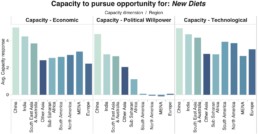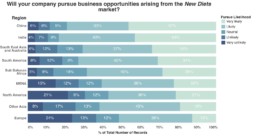A new global diet is an opportunity to innovate. It is about bringing ancient protein rich plants back to our plates and in our fields – and to eat locally produced food.
Diets are closely linked with environmental and human health. Large parts of the world population eat a diet rich in unhealthy refined fats, refined sugars and meat – and it is taking its toll. People are getting heavier and loose years of healthy and productive living on that account, our planet is getting warmer and our health expenses increase. A global dietary transition that includes putting more local produce and a varied source of proteins on our plates is an opportunity to put people, planet and our common prosperity on a healthy track.

Meat for the Future
Meat is delicious, but it quickly becomes unsustainable if we eat too much. Today we have a great deal of knowledge about our dietary needs and how they can be met in a healthy and environmental friendly fashion, but little of this has been turned into new products leaving ample room for innovation. Securing a wide source of quality proteins in the diet is a prime concern and bringing protein rich plants back to our plates and in our fields can aid this. The demand for plant-based proteins is set to skyrocket in the future offering business an opportunity to innovate and meet consumers’ appetite for novelty. Plankton and insects are attractive candidates for new stable protein-rich meat alternatives. It is about inventing meat alternatives that look, feel and taste like animal meat, with the familiar texture and variation, but with a lower CO2 footprint.
Eating Ugly Food
Supermarkets seem convinced that consumers will not buy food which has the “wrong” weight, size or appearance. However, a recent survey shows that most consumers are willing to buy heterogeneous produce as long as the taste is not compromised.
For some crops, up to 30 percent of a harvest is often deemed too ugly to leave the farm and ends in landfills because it does not meet the societal expectation of what we consider edible. Marketing campaigns by retailers, governments and schools are an opportunity to drive a change in the perception of what proper food should look like to drive ugly food onto our plates, not in the garbage.
A New Global Diet
A new global diet is an opportunity for change-makers, such as famous chefs, to take the lead in promoting dietary changes by altering the public perception of local and sustainably produced food. Reigniting an interest in – and a taste for – indigenous foods can help improve nutrition for those at risk of suffering from malnutrition while improving biodiversity.
Business plays a key role in promoting a global dietary shift by pushing healthy and protein-rich meat substitutes onto our plates such as legumes, seaweed and insects. Exploring more varied and protein intensive diets can result in more people consuming the recommended amount of nutrients. Companies can be leaders in this movement by making vegetarian dishes the default option at conferences, on airplanes and in other forums where large groups of people eat.
In all, reintroducing native plants and developing protein-rich meat alternatives are opportunities to address the global food crisis in a way that shapes a healthier planet with healthier people living in healthier economies.
Survey Findings
“New Diets” is the least favored of the three market opportunities to address the current global food crisis surveyed in 2015. Even though, there are great variations between regions, it is fair to say that the world has limited appetite for “New Diets.”

In six out of the nine regions, there is a perceived lack of capacity to pursue this opportunity compared to the 14 other opportunities surveyed in 2015. It is especially the four regions of North America, Europe, other Asia and MENA where confidence in the ability of new diets to change societies for the better is low. The same goes for their perception of the capacity to pursue it. These four regions have particularly limited faith in the political will power to pursue the opportunity of new diets. Sub Saharan Africa and South America; believe that new diets will have positive impact on society, but that the political will to pursue it as low. For Europe, the MENA region, North America and South America the survey data shows that the respondents perceive lack of political will power to be holding the regions back in pursuing this opportunity. For India, South East Asia & Australia and China capacity to pursue this opportunity is perceived to be present.

What you put on the plate is not perceived to be a very effective avenue for addressing the global food crisis, as a new diet is the least preferred of the three market opportunities addressing the food crisis surveyed in 2015. It is not perceived to make a big difference on the greater society as this market opportunity consistently is rated less optimistically on positive impacts on society. “New Diets” shows great differences in rating between medium and very high HDI countries. Medium HDI countries see more potential in new diets as an avenue for positive change than high HDI countries. The surveyed five sectors do not see any particular business case in pursuing the “New Diet” opportunity, and it is believed to have limited influence on their business.
This market was surveyed globally in 2015 by more than 5500 leaders from both the public and private sectors. The survey was conducted in collaboration with the research company YouGov. The survey results were originally published in the Global Opportunity Report 2016.

